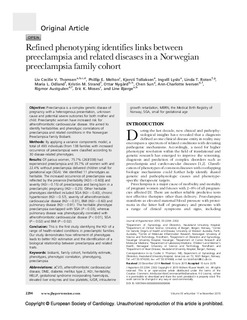| dc.contributor.author | Thomsen, Liv Cecilie Vestrheim | |
| dc.contributor.author | Melton, Philip E. | |
| dc.contributor.author | Tollaksen, Kjersti | |
| dc.contributor.author | Lyslo, Ingvill | |
| dc.contributor.author | Roten, Linda Tømmerdal | |
| dc.contributor.author | Odland, Maria Lisa | |
| dc.contributor.author | Strand, Kristin Melheim | |
| dc.contributor.author | Nygård, Ottar | |
| dc.contributor.author | Sun, Chen | |
| dc.contributor.author | Iversen, Ann-Charlotte | |
| dc.contributor.author | Austgulen, Rigmor | |
| dc.contributor.author | Moses, Eric | |
| dc.contributor.author | Bjørge, Line | |
| dc.date.accessioned | 2015-12-22T10:33:36Z | |
| dc.date.accessioned | 2016-03-04T12:19:24Z | |
| dc.date.available | 2015-12-22T10:33:36Z | |
| dc.date.available | 2016-03-04T12:19:24Z | |
| dc.date.issued | 2015 | |
| dc.identifier.citation | Journal of Hypertension 2015, 33(11):2294-2302 | nb_NO |
| dc.identifier.issn | 0263-6352 | |
| dc.identifier.uri | http://hdl.handle.net/11250/2381432 | |
| dc.description.abstract | Objective: Preeclampsia is a complex genetic disease of pregnancy with a heterogenous presentation, unknown cause and potential severe outcomes for both mother and child. Preeclamptic women have increased risk for atherothrombotic cardiovascular disease. We aimed to identify heritabilities and phenotypic correlations of preeclampsia and related conditions in the Norwegian Preeclampsia Family Biobank.
Methods: By applying a variance components model, a total of 493 individuals (from 138 families with increased occurrence of preeclampsia) were classified according to 30 disease-related phenotypes.
Results: Of parous women, 75.7% (263/338) had experienced preeclampsia and 35.7% of women with and 22.4% without preeclampsia delivered children small for gestational age (SGA). We identified 11 phenotypes as heritable. The increased occurrence of preeclampsia was reflected by the presence [heritability (H2r) = 0.60)] and severity (H2r = 0.15) of preeclampsia and being born in a preeclamptic pregnancy (H2r = 0.25). Other heritable phenotypes identified included SGA (H2r = 0.40), chronic hypertension (H2r = 0.57), severity of atherothrombotic cardiovascular disease (H2r = 0.31), BMI (H2r = 0.60) and pulmonary disease (H2r = 0.91). The heritable phenotype preeclampsia overlapped with SGA (P = 0.03), whereas pulmonary disease was phenotypically correlated with atherothrombotic cardiovascular disease (P < 0.01), SGA (P = 0.02) and BMI (P = 0.02).
Conclusion: This is the first study identifying the H2r of a range of health-related conditions in preeclamptic families. Our study demonstrates how refinement of phenotypes leads to better H2r estimation and the identification of a biological relationship between preeclampsia and related traits. | nb_NO |
| dc.language.iso | eng | nb_NO |
| dc.publisher | Wolters Kluwer | nb_NO |
| dc.title | Refined phenotyping identifies links between preeclampsia and related diseases in a Norwegian preeclampsia family cohort | nb_NO |
| dc.type | Peer reviewed | nb_NO |
| dc.type | Journal article | |
| dc.date.updated | 2015-12-22T10:33:36Z | |
| dc.description.version | publishedVersion | |
| dc.source.volume | 33 | nb_NO |
| dc.source.journal | Journal of Hypertension | nb_NO |
| dc.source.issue | 11 | nb_NO |
| dc.identifier.doi | 10.1097/HJH.0000000000000696 | |
| dc.identifier.cristin | 1263886 | |
| dc.description.localcode | Copyright 2015 Wolters Kluwer Health, Inc. All rights reserved. This is an open-access article distributed under the terms of the Creative Commons Attribution-NonCommercial-NoDerivatives 4.0 License, where it is permissible to download and share the work provided it is properly cited. The work cannot be changed in any way or used commercially. | nb_NO |
